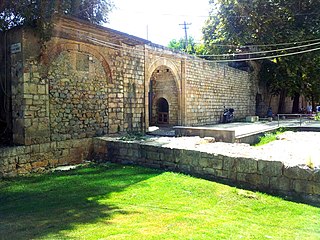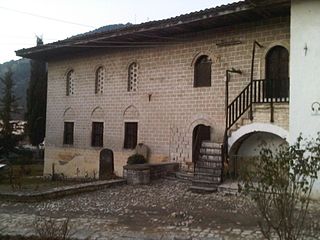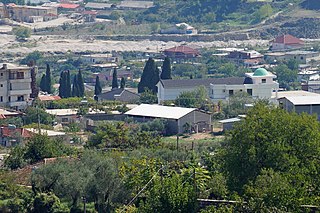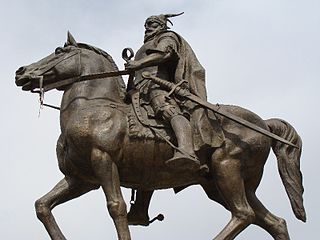
Fier is a city and a municipality in Fier County in southwest Albania. The population of the municipality at the 2011 census was 85,845.

Fortress of Justinian or simply known as Tirana Castle is a castle in Tirana, Albania. Its history dates back before 1300 and is a remnant from the Byzantine-era. The fortress is the place where the main east-west and north-south roads crossed, and formed the heart of Tirana. The current fortification has three known towers and it is undergoing a process of restoration, for touristic purposes. Inside the fortified walls of the former fortress, there are many buildings that can be visited, including restaurants, hotels, and cultural institutions.

The Skanderbeg Monument is a monument in the Skanderbeg Square in Tirana, Albania. It commemorates Skanderbeg, the national hero in Albania for resisting the Ottomans.

Holy Transfiguration Church is an orthodox church in Gjirokastër, Albania. The church was built in 1784. It is a Cultural Monument of Albania since 1963.

The King Mosque, also known as the Sultan's Mosque or Sultan Bayezid Mosque, is a mosque and a Cultural Monument of Albania, located in Berat. It was built in the 15th century by the Ottoman sultan Bayezid II for the local Albanian population. The mosque became a Cultural Monument in 1948.

The Bachelors' Mosque, formerly the Sylejman Pasha Mosque, is a Cultural Monument of Albania, located in Berat. It became a Cultural Monument in 1961.

The White Mosque is a ruined mosque in Berat Castle, Berat, Albania. From the small, roughly square mosque there are still about a meter high foundation walls and the base of the minaret, a little over two meters high. It was built with white limestone.

The Fatih Mosque is a Cultural Monument of Albania, located in Durrës. It was built in 1502 and named after the Ottoman Turkish Sultan Mehmed the Conqueror (Sulltan Mehmet Fatihu). Closed by the Communist authorities, it became a cultural monument in 1973. Its minaret was torn down but rebuilt in a more simple style after the Communist dictatorship had ended.

The King Mosque or Sultan Bayezid Mosque is a historical mosque in Elbasan Castle, Elbasan, Albania. The mosque was builted by Sultan Bayazit II around 1482-1485. This makes it the oldest active mosque in Albania. It became a Cultural Monument of Albania in 1948.

The Naziresha Mosque is a Cultural Monument of Albania, located in Elbasan. It was built in 1599 by a Naziresha (Nazire), the daughter of a Nazır (minister). After being partly damaged in 1920 due to an earthquake, it became a Cultural Monument in 1948.

The Kapllan Pasha Tomb is a Muslim Türbe of Albania, located in the center of Tirana. It is a Cultural Monument of the first category and was so declared by the government of Albania in 1948. It was built in the early 19th century, with carved stones and has an octagonal shape. The columns are made of stone, and placed also on stone bases and capitals with plant decor on the surface. The former ruler of Tirana was interned here in the 19th century, but was later repatriated back to Istanbul, Turkey.

The Bride's Tomb is a Cultural Monument of Albania, located in Mullet, Tirana County.
The Sheh Dyrri Tekke is a teqe in Tirana, Albania. It is a Cultural Monument of Albania.

The Teqe Mosque is a mosque in Gjirokastër, Albania. It is a Cultural Monument of Albania.

The Zall Tekke is a Bektashi teqe in Gjirokastër, Albania. It is a Cultural Monument of Albania.
Kamenicë Church is a ruined church in Palavli, Delvinë, Albania. It is a Cultural Monument of Albania.

Skanderbeg Square is a square in Skopje, North Macedonia.

The Architecture of Albania is a reflection of Albania's historical and cultural heritage. The country's architecture was influenced by its location within the Mediterranean Basin and progressed over the course of history as it was once inhabited by numerous civilisations including the Illyrians, Ancient Greeks, Romans, Byzantines, Venetians, Ottomans as well as modern Austro-Hungarians and Italians. In addition, missionaries, invaders, colonisers and traders brought cultural changes that had a large profound effect on building styles as well as techniques.















